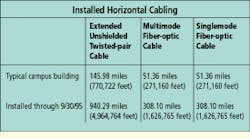Recabling in an occupied building requires careful planning
Roger Adams,
Sandia National Laboratories
Timothy Francis,
Holmes and Narver Inc.
Problem
Recabling in an occupied building is inconvenient for occupants--who are concerned with office or laboratory security, damage to equipment and misplaced furniture--and also involves additional time and effort for the installer because of daily setup and cleanup requirements. Recabling a laboratory or office building at Sandia National Laboratories generally requires one year to complete, and in many instances, renovation projects overlap. Different contractors sometimes work in the same area, which can result in delays, change orders and added expense.
Solution
Close coordination with project managers can alleviate some of the confusion that occurs when multiple projects are conducted in the same area of a building. In addition to effective communication and diplomacy when dealing with other contractors and building occupants, the project manager should keep track of any design changes, materials and costs, while adhering to the schedule. The following lessons were learned as a result of Sandia`s recent intrabuilding recabling project.
Procedure
1) In the design phase, lock in the final location and number of multimedia outlets as early in the process as possible.
2) Keep track of all cabling as it is used. You can save money and ensure consistency in material by purchasing and storing enough material for the entire project.
3) If occupants cannot move to a temporary work space, schedule cabling for nonbusiness hours.
4) Maintain and post a design-change deadline so all concerned parties are aware of cutoff dates. (Occupants may want to change outlet locations up through installation.)
5) Ensure that the project manager is the only liaison among contractors, occupants and inspectors. Do not allow building occupants to direct installers.
6) Ensure that occupants are aware of the proposed construction and cabling schedule and any in-process modifications as early as possible.
7) Each night, record the location, work completed and materials used by the installers.
8) If possible, have an inspector conduct a quick check at the end of each shift. Accurate records will be invaluable in the event that any equipment is damaged.
9) Adhere to the design, standards and schedule under all but extreme circumstances.
Roger Adams, Registered Communications Distribution Designer (RCDD), is a member of the technical staff at Sandia National Laboratories and Timothy Francis, RCDD, is senior telecommunications specialist at Holmes and Narver Inc., both in Albuquerque, NM.

